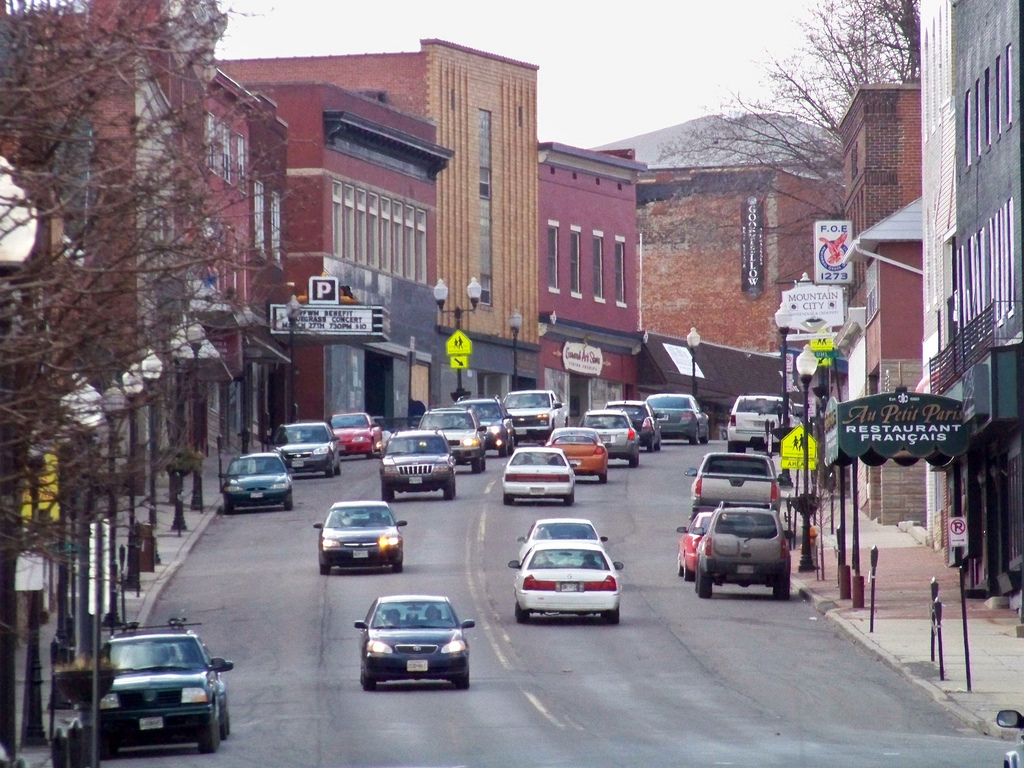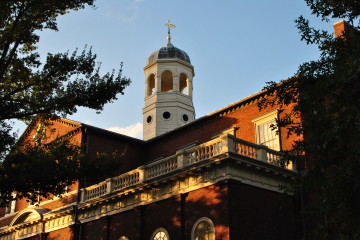Frostburg’s Main Street Faces Challenges in a Changing World
Walking down Frostburg’s Main Street, one cannot help but notice the dilapidated, boarded up storefronts nestled between offices and bars. It seems as though there is much prime real estate available in what is meant to be the busiest, most commercial part of town. So why are all of these buildings sitting empty?
It is no secret that Allegany County as a whole has been struggling economically for some time. One indication of these economic woes is shown through the county’s unemployment rate, which the Frostburg City website cites as 6.9 percent, compared to the national rate of 5.5 percent. Frostburg’s is even higher, at 8.6 percent.
A change in the type of industry in the area may be to blame for these higher than average figures. According to the 2012 Allegany County Economic Development Plan, “Allegany County experienced population and labor force loss as the factories aged, downsized, or closed.” Over the last 35 years, manufacturing jobs dropped from almost 28 percent of total employment in the county to just 8.3 percent.
Paired with the loss of many manufacturing jobs impacting the local economy, there is another big challenge for Main Street’s commercial endeavors. America’s shopping habits have shifted dramatically in just a few short decades, leaving many traditional Mom-and-Pop shops by the wayside.
Frostburg City Administrator John R. Kirby Jr. explained this shift. “There was a time,” he said, “when most people shopped for clothing, shoes, jewelry, furniture and other general merchandise in the central business district of their city or town. During the last two to three decades of the 20th century, that shopping was found at the ‘mall.’ Then came the ‘big box stores’ like Walmart, which consumed even more shopping. Finally in the 21st century, online shopping has grown and grown to be the most important element of retail in America today.”
In order to survive, many of the businesses that remain on Main Street have survived by adapting. “Frostburg’s Main Street has lost clothing stores, a shoe store, two jewelry stores, three furniture stores and other general merchandise retailers,” said Kirby. “Those retailers still in the Frostburg central business district are primarily specialty shops…or those who also have a healthy online side to their business.”
One such business is the Draft Sports Bar & Grille, which opened in June 2014 on East Main Street. Owned by Greg and Vivian Diehl, the bar and grille took over the building previously occupied by the Hangar. The Draft has an active Facebook presence, advertising weekly specials and what games they will have on for a given night.
The Diehls were not concerned about the closures of other restaurants on Main Street when they went to open theirs, despite not having any prior experience in the restaurant business. Greg Diehl explained, “We didn’t have the knowledge for a restaurant, so that’s why we tried to build some people around us who did.”
Vivian Diehl seemed optimistic about the state of Main Street, commenting, “I think they are making a great effort in improving it, and bringing in some other businesses.”
Kirby seemed optimistic, too: “There has been a number of new small, specialty shops open just in the last year. There are several new restaurants, serving unique foods. The effort to focus on arts and entertainment opportunities and venues continues, in partnership with The Allegany Arts Council and Frostburg State University. The community has developed a number of unique festivals and special events to attract locals and tourists.”
Of course, the presence of the university has a significant financial impact on Main Street, as well as Allegany County as a whole. This impact was measured in October 2012, in a study called Economic Impact of Frostburg State University on the Surrounding Region and the State of Maryland.
According to the study, FSU contributed $121.2 million to Allegany County alone in fiscal year 2012, through “faculty, staff, and student expenditures, as well as FSU institutional purchases.” $68.7 million of that came from student expenditures, $36.4 million from faculty and staff, and $16.1 million from university purchases.
The university had a $173 million total impact on the State of Maryland in fiscal year 2012.
Dr. Sudhir Singh, Interim Dean of the College of Business at FSU, was one of the faculty members that oversaw the study. He emphasized that the findings of the economic impact study were only a “conservative estimate.”
According to Singh, the study “came from a request from Dr. Gibralter, our former president, who felt that it is important for this institution to document its economic impact, not just on Frostburg city but also on the surrounding region.”
He explained that the study did not get so specific as to quantify the university’s impact on the city of Frostburg itself, as that would be “very difficult to measure.” He made the point that while sometimes residents shop for groceries in Frostburg, they may also sometimes venture to La Vale or other places within the county to shop.
Singh strongly believed this study to be of great importance to the university, in the sense that it would allow it to advocate for its own worth. “We’ve done this in good faith, we’ve done this with a lot of humility,” he explained. “But I think what was important was for us to actually be able to, quite frankly, make a case to the legislators, also to our own stakeholders including our own board of advisors, to visitors, parents and others that we are a very durable university.”
Greg Diehl reported seeing a difference in business when the university’s school year ended. He explained, “it definitely impacts our business whenever [the students are] here. Summer was slower, people were taking vacations. I mean, the city has half the population that it has whenever the students are here.”
FSU has helped development on Main Street in the non-profit sector as well. After the Lyric Theater Building burned in 2004, a developer from Washington, D.C. was able to reconstruct the building “based on having FSU as the anchor tenant on the first floor…Without FSU the Lyric Theater Building would still be a burned out shell, owned by the city,” according to Kirby.
Another factor that impacts business on Main Street is the Western Maryland Scenic Railroad (WMSR). According to Kirby, it attracts “upwards of 40,000 visits a year to the city.”
Desiree Bullard, public relations representative for the WMSR, said that “on our busiest days we may bring up to 500 or 600 people to Frostburg. Of course we are not always that busy, but on the days that we run we generally bring at least 100-150 people to Frostburg.” As of October, the WMSR has had 106 operating days so far this year.
The Scenic Railroad runs from May through December each year, offering different types of experiences depending on the season, including rides focused on viewing the changing leaves, and the “North Pole Experience,” where Santa is there to meet riders when they arrive at the Frostburg Depot. The ride begins in Cumberland, heading up to Frostburg with a 90-minute layover there before heading back to Cumberland.
Jessica Palumbo, Frostburg’s Main Street manager with the Frostburg First program, said that “the biggest challenge is trying to figure out how to get these people up the hill onto Main Street in 90 minutes and have them eat, shop, and go back to the train.”
On the issue of possibly extending the Frostburg layover to give riders more time to enjoy what Main Street has to offer, Palumbo said, “I think they’ve already extended it, I think it only used to be an hour. I guess they have this fear that they’re going to take up too much of these people’s time if they extend the time.”
One effort Frostburg First has implemented to solve this issue is a trolley to take riders from the Depot to Main Street, making it more accessible to riders rather than making them hike up the hill. According to Bullard, “the trolley runs every Saturday and Sunday for most of the season. In October, they try to offer it Thursday through Sunday,” as there are more trains running for riders to be able to experience Allegany County’s vibrant fall foliage.
Bullard explained that WMSR reservation agents “always inform guests of their options in Frostburg. Many choose not to climb the stairs or hill and remain at the Depot, but many make the trek up to Main Street.” She also said that “It can be problematic for some people to climb the stairs and hill to get to Main Street, and it most certainly eats up some of that layover time.”
While business on Main Street certainly has its challenges, there is reason for hope, too.
According to Palumbo, “in the past year we’ve had five places open. Five stores open, none of them have closed, which is a great thing. And they’re all really great, and really quality places that I think will do really well here.”
On the future of Frostburg’s Main Street, Kirby had this to say: “It will be different from the Main Street of the 1960s, but still a great place.”
Featured picture credited to Allegany Arts Council.





1 Comment